I never thought of myself as a procrastinator, until recently, that is. Reflecting on several “difficult” tasks, I realized that I was putting them off, to my own detriment. So last month, I decided to begin with one so-called “hard stuff” items and meet it head-on.
In my case, the hard stuff has to do with self-care. I spend a lot of time addressing the needs of my family, not to mention completing volunteer work for several local seniors’ organizations. What I don’t do is address my needs first—you know, put on my own oxygen mask before helping others’ with theirs. Although I have written about this exact topic on several occasions, I wasn’t practising what I was preaching. What did I need to address in terms of self-care? The biggest issue for me was my ballooning weight gain. Part denial, part resignation to my aging body, I believed things were beyond my control. I don’t drink, I cook from scratch, and I’m very physically active (including the recommended 2 strength training sessions per week), so it must just be the vagaries of a post-menopausal body was my thinking. It was time to do the hard stuff, including but not limited to:
While some of you may think this list is feeble and/or not that difficult, I say to you, hard stuff is entirely subjective. This is my hard stuff and it’s been the focus of the past month. And trust me, it feels really hard. In fact, I think the hardest part of all is telling you that I’m on a weight-loss journey. In some ways, it feels like defeat that I need to do this in the first place. As I head towards my second month, I can happily report that the number on the scale is heading in the right direction. And while I still find many of these tasks difficult to do, I also feel a sense of empowerment as I take control of my health and focus on me first. In my case, doing the hard stuff first is a positive step that has helped me move beyond procrastination. For now, at least.
0 Comments
The Canadian Medical Association (CMA) and the National Institute on Ageing reported recently that 96% of Canadians want to age in place. They want to stay in their own homes as long as possible and stay independent at the same time.
It may be something you or your loved ones are contemplating in the golden years. It’s a hot topic in our household, as the grandparents on both sides of the family continue to appreciate aging in place. An often overlooked aspect of aging in place is the importance of preventing a life-altering fall. As we age, our risk of falling increases, along with the likelihood that a fall will cause an injury. In fact, falls are the leading cause of injury among older Canadians, with 20 to 30 per cent of seniors experiencing one or more falls each year. Half of all falls happen in the home—the very place older adults spend most of their time. Since 2019, I have published six books geared to supporting seniors with fall prevention. My goals with these books are to help seniors:
Sometimes, though, seniors don’t want to hear about or discuss fall prevention. I’ve seen this firsthand at recent book signings. A senior will slow down to see the books on my display table. As soon as they register the topic, they’ll beat a hasty retreat. Some of them will shake their heads and tell me they don’t need fall prevention help. But the fact is a fall can happen at any time. And there are many factors that contribute to the risk of a fall:
If aging in place is on your radar, I hope this article will provide some practical tips to stay independent as long as possible. And while I regularly tout the benefits of regular physical activity to prevent falls, the non-exercise fall prevention tips are just as important as the exercise tips. They include:
And if you need help with the exercise side of fall prevention, please feel free to reach out. I can recommend one of my six publications, based on your requirements. Or you can find out more information in the books section. In closing, please indulge me while I share my favourite movement-based catchphrases and quotes:
 As we age, we tend to slow down. Our muscles shrink, our vision blurs, and our reaction time diminishes. Together, all of these factors lead to an increased risk of falling. We can work on muscle strength to help avoid a fall. But sometimes, we need to take a break from standing up. During these sitting periods, chair exercises can help you strengthen your muscles and increase your confidence when you do have to stand up and move around. When you do chair exercises daily, you reduce the risk of falls. The movements increase blood flow and keep your joints active and lubricated. Chair exercises come in handy when you have limited mobility or find it hard to maintain your balance. Bottom line, you’re improving your balance while seated.
Here’s what one customer had to say:
“About as comfortable and easy to get with and go with. Has really helped me and the need for equipment is not a factor. It makes it clear that the best exercise equipment we have is our own bodies. We just have to have information on how to use them. Highly recommend and would give as a gift even as I know it to be valuable and worthy of giving and receiving and definitely using.” The book includes a series of workout plans, to help guide readers through four gentle, seated workouts that focus on balance, posture, strength, and flexibility. Each exercise includes step-by-step instructions, basic illustrations, and recommendations to make each exercise easier or harder. Several stores in Ottawa are selling this title; you can find out which ones by visiting the book section of my website. If you’re further afield, visit Amazon to purchase your copy today! 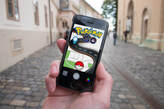 Image by Stux Image by Stux Whenever I’ve been asked what exercise someone should do, my response is always along the lines of: do something you enjoy. You are more likely to stay physically active if you actually like the activity you’re doing. For me, my favourite way to move is walking. I walk a lot. Always have, always will. For the record, though, I also engage in strength training twice a week, various functional fitness workouts weekly, as well as more cardio-focused options like running and bicycling on a regular basis. But walking is still my favourite mode of physical activity. Having said that, even I find walking a challenge in poor weather conditions. Our winters can be long, snowy, cold, icy, and unpredictable. Last year, I purchased a one-month’s pass to an indoor running track towards the end of the winter to keep me moving. This year, I wasn’t feeling the need to run, so I didn’t repeat this purchase. Yet I knew that I needed some added motivation for my walks, which led me to Pokemon Go. First released in 2016, “Pokémon GO is a 2016 augmented reality (AR) mobile game, part of the Pokémon franchise, developed and published by Niantic in collaboration with Nintendo and The Pokémon Company for iOS and Android devices. It uses mobile devices with GPS to locate, capture, train, and battle virtual Pokémon, which appear as if they are in the player's real-world location.” On January 1st, I downloaded the game to my phone and got walking. And let me tell you, it’s been so much fun. And it’s keeping me consistent with my step count year over year. Pokémon GO has helped promote physical activity for people of all ages, including teens who love to play video games. I hope you are able to find a suitable motivation to get moving every day. For now, I will bid you adieu. It’s time for me to go for a walk and catch some Pokémon.
Remember: move more, feel better. Check out the world of Pokémon here.
Exercise is a subset of physical activity that is: planned, structured, repetitive, and for the purpose of conditioning the body. It is safe to say that all exercise is movement, but not all movement is exercise. And that’s okay, because physical activity lies on a continuum, it’s not an all-or-nothing endeavour. I refer to this continuum as NEAT™ to Elite. What’s the alternative to exercise? NEAT™, non-exercise activity thermogenesis, or incidental activity. NEAT is all the ways your body burns energy that is not eating, sleeping, or dedicated exercises. NEAT relates to moving about in daily life. These small, brief muscular movements are just as important as that gym workout in burning calories. You need both exercise and non-exercise activity in your life, but it’s that non-exercise activity that we have lost in our daily lives. That movement has been replaced by appliances and apps—labour-saving devices that have robbed our bodies of the physical activity, or labour, that we used to do on a daily basis before the technological revolution made movement almost obsolete. NEAT™ is different than your workout at the gym because it relates to moving about in daily life. Research suggests that light physical activity like NEAT™ is as beneficial to older adults and previously sedentary individuals as more vigorous exercise is for younger and more physically fit Canadians. Our grandparents’ generation didn’t need fancy gym equipment or flashy workout gear. Their lives required more movement than our current way of living. There were no labour-saving devices like garage door openers, TV remotes, and online shopping. They didn’t outsource physically demanding tasks like housework and snow shovelling. They just moved—a lot. Looking at the other end of the physical activity continuum—i.e., vigorous exercise, or what I refer to as elite—tends to be associated with amateur and professional athletes. Even at the elite level, athletes are paying attention to the continuum of physical activity and adapting their training accordingly. They balance high intensity and lower intensity workouts on a daily basis; their “zero to 60” performance only kicks in at specific times. Only a small fraction of their training and competition time is spent at the high-performance level. Here’s how elite triathlete Patrick Smith explains it: “You have to find a balance. You can train at a nine or 10 but you have to be able to come back the next week, the next month, and stay injury-free.” They pace themselves, and so should you. Our bodies need both exercise and non-exercise activity every single day. Physical activity at any intensity helps prevent and manage chronic health conditions like heart disease, type 2 diabetes, and some forms of cancer. It also improves your mental health, by curtailing symptoms of anxiety and depression, and improving overall well-being. Physical activity that is accumulated in sporadic bouts throughout the day still reduces the risk of early death. Just because you can’t make it to the gym doesn’t mean you can’t be active. Rethink your activities: Go for a walk, play with your kids or grandkids, clean the house, or do some gardening. These are small steps that can lead to big change, because they get your body moving—to be physically active. About Move More, Your Life Depends On It: Need help fitting physical activity into your daily routine? Learn how to embed healthy habits into each day and improve your overall wellbeing. If you like accessible convenience, approachable information, and making a change for the better, then you’ll love this handy guidebook. Order your copy today! 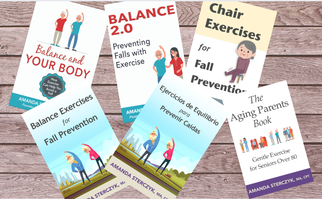 In the past week, I’ve had three separate requests for more details on the seniors’ exercise guides I have published. To date, I have written and published 6 books focused on helping seniors prevent life-altering falls and stay in their own homes longer. While there is some crossover with the books, each one has a unique focus. This month’s blog post will focus on these 6 books, but you can see a snapshot of all my books on my recently-updated website. These books are self-help exercise guides for caregivers, family members, and, most importantly, seniors. They all feature foundational exercises with step-by-step instructions and illustrations that they can use as a home-based exercise plan. The exercises don’t require special equipment or the need to get on the floor—any lying-down exercises are safe to perform on a bed. Each exercise also includes modifications on how to make it easier—or harder, in some of the more advanced books—depending on abilities. Falls are the leading cause of injury, emergency room visits, and hospitalizations for seniors in North America. The goal with my books is to help seniors increase their confidence—after all, the fear of falling contributes to the risk of falling—and improve their strength and balance so they won’t sustain a life-altering fall. Some of these titles are available for sale in Ottawa, while all of them can be ordered online from Amazon. And you can check out the table of contents with Amazon’s “Look Inside” feature if you want more details. Foundations of Balance and Fall Prevention (2-book series). The books Balance and Your Body and Balance 2.0 are standalone books, but can also be purchased together as the Foundations of Balance and Fall Prevention series. Both books are divided into three sections: The Problem, The Solution, and The Action Plan, which include a background on falls and fall prevention, personal stories, and targeted exercises. 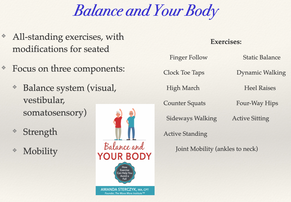 Balance and Your Body features all-standing exercises, with modifications for seated options where possible. It focuses on three components:
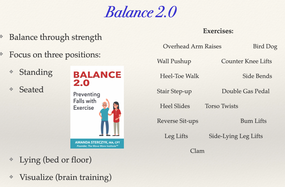 Balance 2.0 focuses on balance through strength. It features exercises in three positions: - standing - seated - lying (bed or floor) Also included are visualizations to help with brain training. Balance Exercises for Fall Prevention 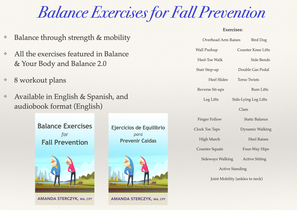 Balance Exercises for Fall Prevention is available in English and Spanish, and there is an audiobook of the English version. If you want just a straight exercise guide, this book has all the exercises featured in Balance and Your Body and Balance 2.0, while the background information on falls and fall prevention has been removed. It also includes 8 workout plans and an exercise breakdown by goal—balance, posture, strength, and flexibility. Chair Exercises for Fall Prevention 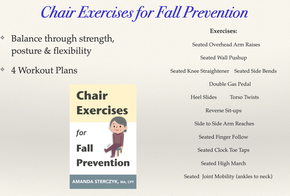 Chair Exercises for Fall Prevention features seated exercises only and includes 4 gentle, seated workout plans that focus on balance, posture, strength, and flexibility. The Aging Parents Book 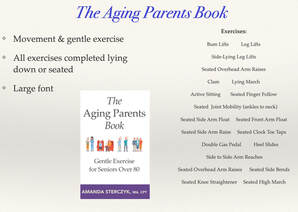 The Aging Parents Books: Gentle Exercise for Seniors Over 80 is a movement and gentle exercise guide. All of the exercises in this book are completed lying down on a bed or seated in a chair. The font size has been increased and the font style has been changed, to improve readability for those with eyesight challenges. If you’re still unsure about which book is right for you, or have any other questions, please feel free to reach out. 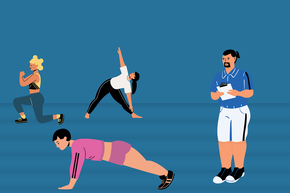 Image source: Elf-Moondance Image source: Elf-Moondance Unless you have been living under a rock, you are fully aware that Canada’s health care system is broken. More than one simple break, the problem is akin to a car window that shatters into thousands of tiny pieces on impact. Many problems that require many steps to fix all of the breaks. It is going to take years to dig us out of this hole, and it will require policy changes across the spectrum. I liken it to a giant cross-country jigsaw puzzle that can only be completed in small steps. Today, I want to address one potential component regarding the shortage of family doctors in Canada. The adoption of multidisciplinary health care teams, also known as team-based care, is vital to the future viability of our health care system.
When it comes to team-based care, a key component must be the inclusion of exercise professionals on these teams. The World Health Organization has identified physical inactivity as the fourth leading risk factor for premature death: "Regular physical activity is proven to help prevent and manage noncommunicable diseases (NCDs) such as heart disease, stroke, diabetes and several cancers. It also helps prevent hypertension, maintain healthy body weight and can improve mental health, quality of life and well-being.” (WHO guidelines on physical activity) In fact, the Ontario Kinesiology Association has been advocating for the inclusion of exercise-specific professionals to be included on all primary care teams in the province: "Exercise and physical activity are recognized unequivocally as among the most effective means to both prevent and manage chronic disease. Managing these illnesses is critical: Chronic conditions such as cancers, cardiovascular diseases, diabetes and chronic respiratory disease are the leading cause of death in Ontario. The cost of supporting individuals with chronic disease is estimated to be 55% of total direct and indirect health costs.” Indeed, a Canadian study demonstrated that patients want individualized physical activity recommendations from their primary care physicians. If team-based care is to be successful, not only should dieticians be added to these teams, but also exercise professionals. Lifestyle factors such as diet and exercise would go a long way to reducing the burden of chronic disease on Canadians and our health care system.
Introduction Inactivity can be a vicious cycle, particularly for frail, older seniors. Fear of falling keeps some seniors from getting up and moving more. Unfortunately, lack of movement further weakens muscles, stiffens joints, and reduces the ability to balance. The Aging Parents Book is a movement and gentle exercise guide. The purpose of this book is to show you, or your older loved one, how to do gentle movement-based exercises that will both feel good AND improve mobility and strength, as you (they) go about daily life. This is the sixth exercise book for seniors that I have published. It is different than my other Balance exercise guides, in that all of the exercises are completed either lying down or sitting in a chair. They still address the balance system, strength, posture, and joint mobility. These exercises will improve walking, reinforce good posture, and enhance ease of movement during day-to-day life. This book is all about gentle, low-key movement, so unlike my previous guides, there are no additional instructions on how to make the exercises harder. The font size has been increased and the font style has been changed, to improve readability for those with eyesight challenges. Exercise Sample: Foot Alphabet Copyright: Amanda Sterczyk 2023, all rights reserved.
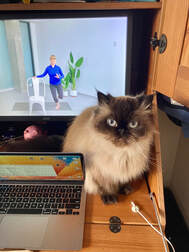 My trusty exercise assistant My trusty exercise assistant Recently, a former student reached out to ask if I’d be willing to teach an Essentrics session for her and a few friends. I spent more than a decade teaching Essentrics in the Ottawa area, but it’s been a few years since I taught a group fitness session. So I thought about it for a few days—specifically, the work involved in setting up and preparing for classes again. In the end, I politely declined and directed her to other possibilities. I no longer teach Essentrics, but it’s still a part of my life. Even before I began the instructor certification process, I had been following the Classical Stretch by Essentrics episodes and DVDs for almost 10 years. It’s a no-impact, (mostly) equipment-free workout that can be done anywhere, and I still include it in my repertoire of exercise. That’s the key for me: it’s part of my exercise options, but it’s not the only one. I believe that variety is the spice of life when it comes to exercise. You see, I don’t live to exercise—and I didn’t either when I was a full-time fitness professional—rather, I exercise to live. As I get older, I appreciate more the importance of switching up workouts to avoid overuse injuries, keeping your brain in the game by learning new things, and making sure that I’m enjoying what I’m doing. So, I do still practice Essentrics, but much less frequently than when I was teaching multiple weekly classes. For the itinerant exercise consumers like me, I offer the following recommendations for incorporating Essentrics into your life. Miranda’s books. Miranda Esmonde-White is the brains, heart, and soul behind Essentrics and is a true Canadian fitness pioneer. She has penned several books on the Essentrics technique, and these are presented below:
No matter how you choose to move your body, please do it often. It will help you in the long run. NOTE: I am no longer an Amazon Associate, so I don't earn commissions from recommended products.
 It’s been five years since I published my first book. At the time, I thought I’d be a one-hit wonder. But I’ve gone on to publish a total of 11 books and one audiobook. So I now confidently introduce myself as a writer, especially since I’m working on my next few manuscripts. In recognition of my five-year authorship anniversary, I’ve been reflecting on what led me to write my first book, Move More, Your Life Depends on It. That was published in 2019, but I founded THE MOVE MORE INSTITUTE™ in 2016. It was an initiative I created to help sedentary individuals learn how to incorporate non-exercise activity into their daily lives. You know, how our grandparents used to live when they didn’t have so many labour-saving devices at their fingertips. Here’s a post about it from 2018, when I appeared on local television to promote my initiative: Living in the nation’s capital—home to the federal government and a multitude of associations and institutes—I wanted a whimsical, tongue-in-cheek title for my initiative. That’s how THE MOVE MORE INSTITUTE™ came into existence. But there was nothing formal or regimented about it. In reality, I was trying to work myself out of a job. You see, as a group fitness instructor and personal trainer, many clients participated in weekly exercise with me. But for many, that was the extent of their physical activity. The rest of their waking hours, they were mostly sedentary at work and home. I was trying to inspire people to sit less, move more--even if that meant they no longer felt the need to attend my classes or hire me for personal training. And that was a problem, because sitting had been identified as the “new smoking." You see, exercise alone isn’t enough. Daily movement that breaks up long periods of sitting is vital. I first read about this concept in the 2011 book, Sitting Kills, Moving Heals, by Dr. Joan Vernikos—the former Director of NASA’s Life Sciences Division. Vernikos was instrumental in astronaut John Glenn’s return to space at the age of 77. Although I wrote about Vernikos’ important work as early as 2014, Vernikos published her first book on the topic a decade earlier— The G-Connection: Harness Gravity and Reverse Aging. Although I can confidently say I’ve been ahead of my time with many of my publications, it is Dr. Vernikos’ ground-breaking research at NASA that led the movement to reduce sedentary time. When I realized in 2018 that many of my blog posts had already touched on this important topic, I knew I wanted to expand on my previous writing and turn it into a book. So that’s my story of how NASA inspired my writing career. If you haven’t had a chance to read Dr. Vernikos' work, I’d recommend any of her books. But my favourite is still Sitting Kills, Moving Heals. Other books by Joan Vernikos, Ph.D.: As an Amazon Associate I earn from qualifying purchases. |
Categories
All
Archives
July 2024
AuthorAmanda Sterczyk is an international author, Certified Personal Trainer (ACSM), an Exercise is Medicine Canada (EIMC) Fitness Professional, and a Certified Essentrics® Instructor. |



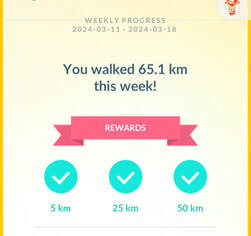

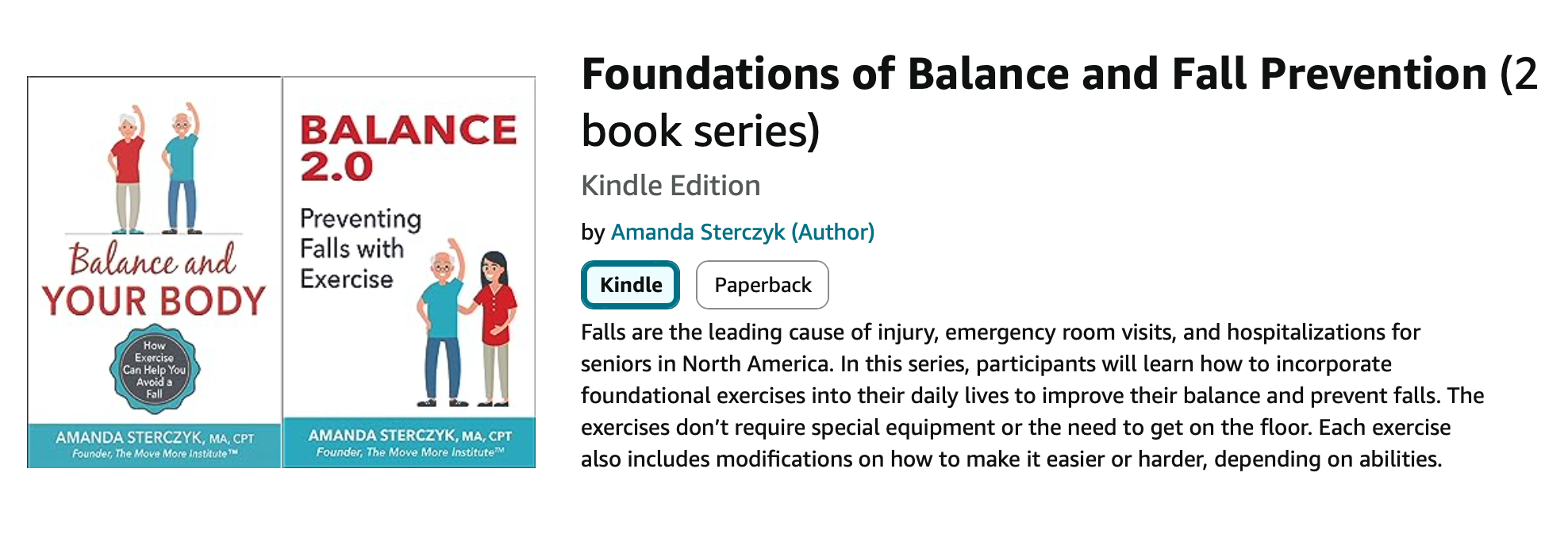
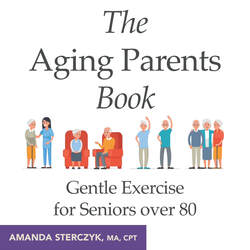
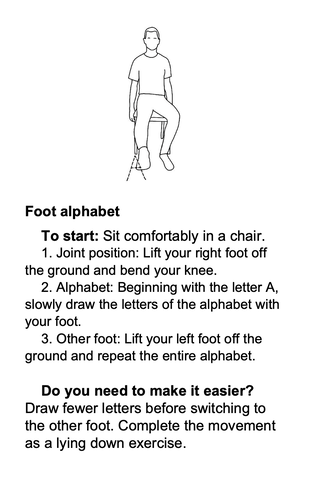
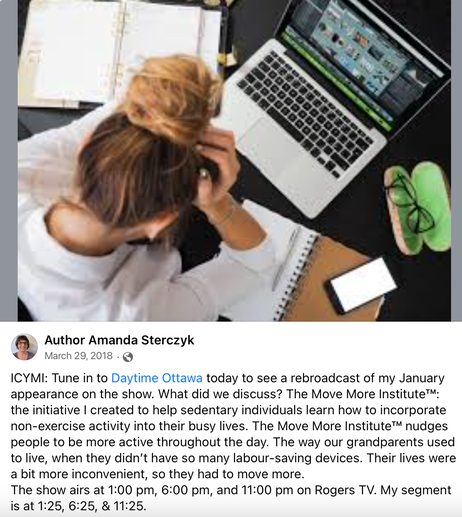
 RSS Feed
RSS Feed